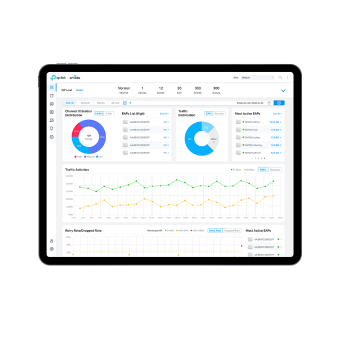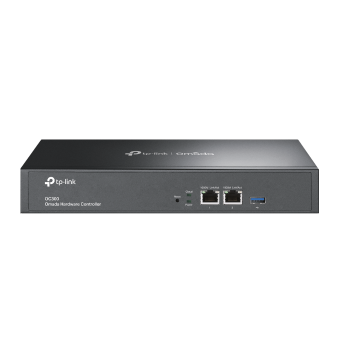Comment utiliser les outils sur le contrôleur Omada
Ce guide présente l'utilisation de trois outils disponibles sur le contrôleur Omada pour le dépannage du réseau.
Scénario d'application
Lorsque le réseau rencontre des problèmes qui doivent être résolus, les outils du contrôleur Omada peuvent vous aider. Ces outils, notamment Network Check, Packet Capture et Terminal, permettent aux utilisateurs d'identifier rapidement la cause des problèmes, de gagner du temps sur le dépannage et d'obtenir une plus grande efficacité.
Comment utiliser la vérification du réseau
L'outil Network Check peut être utilisé pour vérifier la connectivité réseau, identifier la source d'un lien problématique ou rechercher des informations DNS. Le contrôleur Omada propose trois méthodes de vérification du réseau : Ping, Traceroute et DNSLookup.
Compatibilité du contrôleur :
Version 5.9 et supérieure : Compatible avec Switch et EAP
Version 5.12 et supérieure : compatible avec Gateway, Switch et EAP
1. Sélectionnez un site dans la liste déroulante Organisation et accédez à Outils > Vérification du réseau .

2. Entrez les informations de configuration en fonction de vos propres besoins. Par exemple, nous utilisons l'outil Ping pour vérifier la connectivité entre l'EAP (00-FF-34-19-36-49) et la passerelle (192.168.1.1), nous envoyons donc 4 paquets de données d'une taille de 32 octets à l'adresse IP 192.168.1.1 pour voir si la connexion est normale en fonction du message renvoyé.

Explication des paramètres :
|
Paramètres |
Taper |
Explication |
|
Type d'appareil |
La liste déroulante |
Sélectionnez le type de périphérique(s) pour effectuer un test : EAP, Switch ou Gateway. |
|
Source |
Fenêtre contextuelle |
Sélectionnez un ou plusieurs appareils pour effectuer le test. Vous pouvez utiliser la barre de recherche pour rechercher l'appareil spécifique. |
|
Test |
La liste déroulante |
Sélectionnez le type d'outil de test : Ping, Traceroute ou DNSLookup. |
|
Interface |
La liste déroulante |
Sélectionnez le port WAN pour le test. Cette option apparaît uniquement lorsque la passerelle est choisie comme type de périphérique. |
|
Type de destination |
La liste déroulante |
Sélectionnez le type de destination et spécifiez le domaine/l'adresse IP ou le client à envoyer une requête ping. |
|
Tailles des paquets |
Zone de saisie |
La taille d'un seul paquet. Cette option apparaît uniquement lorsque le type de test est Ping. |
|
Comptes |
Zone de saisie |
Le nombre de paquets. Cette option apparaît uniquement lorsque le type de test est Ping. |
|
COURIR |
Bouton |
Cliquez pour démarrer le test. |
Remarque : Veuillez vous assurer que vos appareils sont compatibles avec le contrôleur Omada et qu'ils sont mis à jour avec la dernière version du micrologiciel. Si l'appareil ne prend pas en charge la fonction Ping, Traceroute ou DNSLookup, une note apparaîtra dans la fenêtre contextuelle des Sources.
3. Cliquez sur Exécuter pour effectuer le test.
4. Affichez le résultat dans la section Sortie du périphérique. L'appareil testé est affiché dans la liste des appareils à gauche et le résultat du test est affiché à droite pour une analyse plus approfondie. Vous pouvez également utiliser la barre de recherche pour rechercher le résultat spécifique, envoyer les résultats par e-mail, télécharger les journaux de test, zoomer et dézoomer sur la zone affichée et effacer les résultats affichés.

|
Sortie de l'appareil |
||
|
Liste des périphériques |
Liste |
Cliquez sur différentes adresses MAC pour afficher les résultats des tests pour les appareils correspondants. |
|
Sortie pour l'appareil |
Zone affichée |
Affichez le résultat du test. |
|
Barre de recherche |
Zone de saisie |
Afficher les journaux en fonction des mots-clés de recherche. |
|
|
Bouton |
Send all the longs of the corresponding device to the specific email address. |
|
|
Button |
Download all the logs of the corresponding device from the browser. |
|
|
Button |
Zoom in to view the logs. |
|
Clear |
Button |
Clear the logs of the current device or all devices. |
How to use Packet Capture
The Packet Capture tool can be used to capture data packets transmitted in the network for further analysis.
Controller Compatibility:
Version 5.9 and above: Compatible with EAP
(Only Omada Pro Controller is compatible with Gateway, Switch, and EAP.)
1. Select a site from the drop-down list of Organization and go to Tools > Packet Capture.

2. Enter the configuration information according to your own needs. For instance, when we suddenly fail to access a web page, we can use the packet capture tool to analyze if there is any issue occurred during the TCP three-way handshake process. If the host (IP: 192.168.1.1) fails to ping other hosts, enter “src 192.168.0.1 and dst 192.168.0.1” in the Packet Capture Filters and perform packet capture to analyze ICMP messages for further information.

Note:
1. EAP can capture various wired packets such as ICMP, ARP, TCP, UDP, as well as some multicast and broadcast packets. To ensure the normal operation of the wireless network, capturing air packets on the wireless ports is not currently supported.
2. The Omada Pro Controller supports the Gateway/Switch packet capture. For Switches, it can capture packets that are sent to the CPU (packets trapped/mirrored to CPU), such as TCP, UDP, ICMP, ICMPv6, and others.
Parameters Explanation:
|
Parameters |
Type |
Explanation |
|
Device Type |
Drop-down list |
Only EAP is supported. |
|
Sources |
Pop-up window |
Select a device to perform the test. You can use the search bar to search for the specific device. |
|
Interface Type |
Checkbox |
Select the Wired or Wireless interface type. |
|
Select Port |
Checkbox |
Select the wired port. This option only appears when the Interface Type is Wired. The specific number and other information of the ports varies according to the device. |
|
Band |
Drop-down list |
Select the wireless band. This option only appears when the Interface Type is Wireless. The band (2.4/5/6 GHz) information varies according to the device. |
|
SSID / Interface |
Drop-down list |
Select the wireless port. This option only appears when the Interface Type is Wireless. SSID and mesh interface are supported. For SSID configuration, go to Settings-> Wireless Networks->WLAN. Mesh interfaces include sta and bkhap, which will appear when the device supports the mesh function. |
|
Duration |
Input box |
Specify the duration for packet capture (1-300 seconds). |
|
Single Packet Size |
Input box |
Specify the size of a single captured packet (68-1000 Bytes). |
|
Packet Capture Filters |
Input box |
Enter the filters to capture packets. It can help capture the specific type of packets. Refer to the note in the page. This field is optional. |
3. Click Start Packet Capture.

4. After the packet capture is completed, the Download.pcap File button will be enabled (no longer grayed out). Click on the button to download the captured network traffic file.
Note: The packet capture file is only retained for 10 minutes and can only be downloaded a maximum of 3 times. Please download the file as soon as possible after the capture is completed.
How to use Terminal
The Terminal tool can be used to debug devices or obtain device information through command lines.
Controller Compatibility:
Version 5.9 and above: Compatible with Switch and EAP
Version 5.12 and above: Compatible with Gateway, Switch, and EAP
1. Select a site from the drop-down list of Organization and go to Tools > Terminal.

2. Configure Remote Control Terminal Session. Select a Gateway, Switch, or EAP from the drop-down list of Device Type. Select one or multiple devices in the pop-up window of Sources. You can use the search bar to search for the specific device. If the device does not support the Terminal function, a note will appear in the pop-up window.

3. Click Open Terminal.
4. On the left of the Sessions displays the device list and on the right shows the command-line interface on the Terminal. Enter the command lines to debug the device and obtain the device information.

5. You can also use the search bar to search for the specific command lines and returned messages, download and send them by email, zoom in and out, and clear the displayed area.

|
Device Output |
||
|
Device List |
List |
Click on different MAC addresses to show the test results for the corresponding devices. |
|
Output for the Device |
Displayed area |
Display the test result. |
|
Search bar |
Input box |
Display logs based on the search keywords. |
|
|
Button |
Send all the longs of the corresponding device to the specific email address. |
|
|
Button |
Download all the logs of the corresponding device from the browser. |
|
|
Button |
Zoom in to view the logs. |
|
Clear |
Button |
Clear the logs of the current device or all devices. |
Common Command Lines on Terminal Devices
|
Device Type |
Command Lines |
Function |
|
|
AP |
pwd |
Display the current directory |
|
|
xping ip |
Variable IP address that performs background ping tests. If no IP address is provided as a parameter, it will default to pinging 4 responses. |
||
|
ls |
View files in the current directory |
||
|
echo str |
Print or display a specified string or text. str can be any any arbitrary string. |
||
|
date |
Display the current date and time |
||
|
free |
Display available and used system memory |
||
|
ps |
View running process |
||
|
ifconfig |
Check the IP address of network interface card |
||
|
netstat -r |
View the routing table |
||
|
exit |
Log out/end Terminal |
||
|
Switch |
broadcast <string> |
Send a message to all logged in users |
|
|
logout |
Log out |
||
|
debug |
View information on fan, power status etc. |
||
|
ping |
Ping |
||
|
telnet |
Remotely log in to another host |
||
|
terminal length <length> |
Set the number of lines to display before pagination |
||
|
clear |
Reset certain functions |
||
|
exit |
Exit |
||
|
history |
Display command history |
||
|
show |
Afficher les informations du système |
||
|
passerelle |
aide |
Afficher les commandes disponibles |
|
|
sortie |
Quitter le mode actuel |
||
|
activer |
Activer les commandes privilégiées |
||
|
désactiver |
Désactiver les commandes privilégiées |
||
|
configurer |
Passer en mode configuration |
||
|
montrer |
Afficher les informations sur le module |
||
|
pinger |
Adresse IP ping |
||
|
tracer |
adresse IP traceroute |
||
|
histoire claire |
Effacer les commandes précédemment exécutées |
||
|
redémarrer |
Redémarrer l'appareil |
Note:
1. Toutes les commandes Bash sur les appareils EAP sont accessibles en appuyant deux fois sur la touche Tab. Les commandes CLI sur les commutateurs peuvent être visualisées en saisissant « ? » dans la CLI. L'aide du périphérique Gateway est accessible en saisissant « aide » dans la CLI.
2. Le guide CLI de l'appareil peut être téléchargé depuis le Centre de téléchargement > page spécifique à l'appareil > Manuel. Par exemple, le guide CLI du Smart Switch SG2452LP V1 est accessible à l'adresse :
https://www.tp-link.com/en/support/download/sg2452lp/
Pour connaître plus de détails sur chaque fonction et configuration, veuillez vous rendre dans le Centre de téléchargement pour télécharger le manuel de votre produit.
Est-ce que ce FAQ a été utile ?
Vos commentaires nous aideront à améliorer ce site.
















